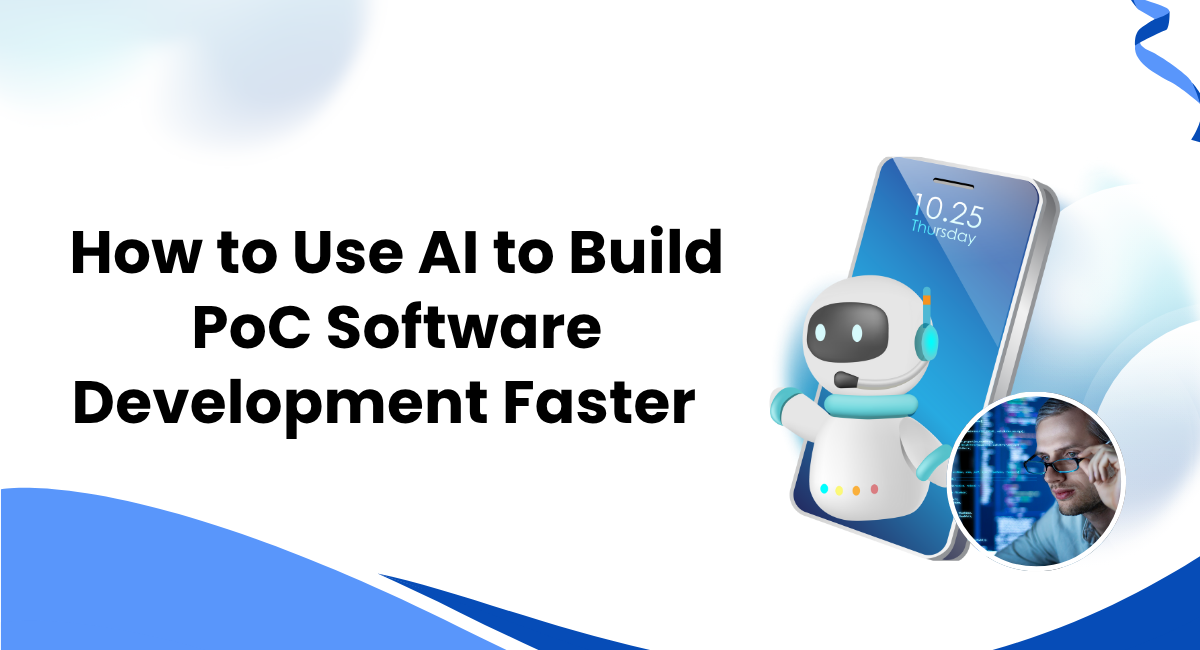
In today’s competitive software landscape, speed matters. The quicker an employer can check a concept and validate it, the faster it can outpace competition. That’s where Proof of Concept (PoC) software development comes in, allowing startups and institutions to validate concepts before making a significant investment. But right here’s the capture: conventional PoC development can nevertheless take weeks or months. Enter Artificial Intelligence (AI)—a transformative pressure that’s accelerating PoC software development like by no means before. Whether you are a startup, enterprise, or a software development company in UK, using AI is no longer optional—it’s a strategic advantage.
This article explores a way to use AI to build a PoC software faster, more efficiently, and with fewer resources
What is PoC (Proof of Concept) in Software Development?
A Proof of Concept is a small undertaking or prototype that demonstrates the feasibility of a specific idea or function in software development. It enables stakeholders to answer questions like:
- Can this concept be technically carried out?
- Is this idea worth additional funding?
- What are the risks involved?
Why Speed Matters in PoC Development
Speed is important in PoC improvement because:
- It shortens the time-to-market.
- It reduces development fees.
- It permits faster feedback from users and buyers.
- It facilitates pivoting more quickly if the concept isn’t feasible.
Traditional coding processes require time-consuming tasks like writing boilerplate code, putting in place infrastructure, and manually trying out—all of which sluggish down PoC transport. AI changes this recreation.
How AI Accelerates PoC Software Development
Let’s break down how AI is being used throughout special ranges of PoC software development:
1. Idea Validation with AI-Powered Market Analysis
Before any coding starts, AI gear can analyze marketplace traits, consumer behavior, and competitor performance to validate whether or not the idea has benefits. Tools like:
- ChatGPT or Claude for ideation and competitor evaluation.
- Google Trends and Predictive Analytics Platforms for demand forecasting.
- AI-based sentiment evaluation equipment for social media and customer reviews.
This reduces the time needed for manual research and enables defining the PoC scope quickly.
2. Automated Code Generation
AI code mills like:
- GitHub Copilot
- Tabnine
- Amazon CodeWhisperer
Can appreciably reduce the time it takes to put in writing boilerplate and repetitive code. This equipment helps builders by autocompleting functions, generating UI components, or even writing complex algorithms with simple actions.
Instead of spending days writing preliminary code, you can have a running prototype in hours.
3. Rapid Prototyping with Low-Code/No-Code AI Tools
AI-driven low-code/no-code platforms such as:
- OutSystems
- Mendix
- Bubble
- Appgyver
Allow business users and product managers to construct brief, visible PoCs without significant programming. With drag-and-drop capability, templates, and AI-assisted layout, those platforms are ideal for building MVPs and validating UI/UX speed.
4. AI-Driven Testing and Debugging
Testing is a bottleneck in any software development cycle. AI can assist in automating:
- Unit exams technology (e.g., Diffblue Cover)
- Bug detection and idea (e.g., DeepCode, Codiga)
- Performance trying out and optimization recommendations
AI checking out tools can simulate a person’s conduct and identify issues even before guided QA starts, resulting in faster iteration and comment loops.
5. Infrastructure Automation with AI
Setting up CI/CD pipelines, deployment environments, and backend servers may be time-consuming. AI-powered DevOps tools like:
- Ansible with AI automation
- Puppet
- Harness
Help you configure infrastructure, automate deployments, and monitor systems correctly, reducing time and human mistakes in the course of the PoC stage.
6. AI for UI/UX Design
Design is just as important in a PoC as functionality. AI-powered layout gear like:
- Uizard
- Figma AI plugins
- Designify
Can create wireframes, UI displays, and even suggest layout upgrades, shortening the layout lifecycle and supporting non-designers’ fast, iterative visuals.
7. Real-Time Feedback and Analytics
AI can also play a role in reading user interactions with your PoC:
- Heatmaps (e.g., Hotjar with AI improvements)
- User analytics (e.g., Mixpanel, Amplitude)
- Feedback clustering with NLP (Natural Language Processing)
These insights allow you to first-class track the product path, making the PoC more valuable to stakeholders.
Benefits of Using AI for PoC Development
- Faster time-to-feel: Build and validate thoughts rapidly.
- Cost-powerful: Reduce developer workload and aid utilization.
- Iterative upgrades: Quicker remark loops and optimization.
- Cross-purposeful collaboration: Empower non-tech stakeholders to participate.
Challenges to Watch Out For
- Over-reliance on AI: Always confirm AI-generated code for common sense and safety.
- Tool compatibility: Not all AI equipment integrates properly with present stacks.
- Learning curve: Teams need education to get the maximum out of AI systems.
Best Practices to Follow
- Start with clear PoC desires.
- Use AI for repetitive and occasional-level tasks, not critical commercial enterprise logic.
- Combine AI tools with an agile method for instant iterations.
- Document the entirety—AI code guidelines may not usually be self-explanatory.
- Get ordinary human oversight and opinions of AI-generated output.
Future of PoC Development with AI
The future guarantees even greater powerful AI abilities:
- AI sellers that can build complete apps from activities
- Voice-primarily based coding assistants.
- AI layout-to-code equipment that immediately converts Figma documents to React/Flutter components.
- Smarter infrastructure orchestration tools with predictive scaling.
As AI will become extra integrated into improvement workflows, building PoC software ought to quickly be as rapid as expressing an idea.
Conclusion
Artificial Intelligence is revolutionizing PoC software development via automating coding, design, testing, infrastructure, and evaluation. It allows you to deliver thoughts to existence quicker, validate concepts affordably, and iterate at lightning speed. Nowadays, hire software developers with expertise in AI-driven development is the best course of action, regardless of whether you’re a startup founder or an enterprise CTO.







